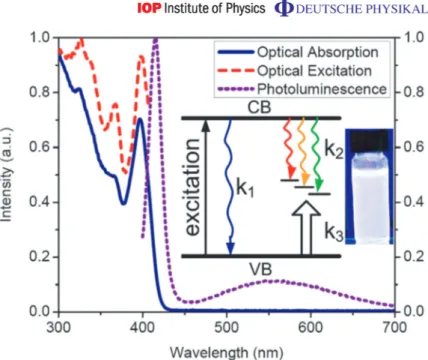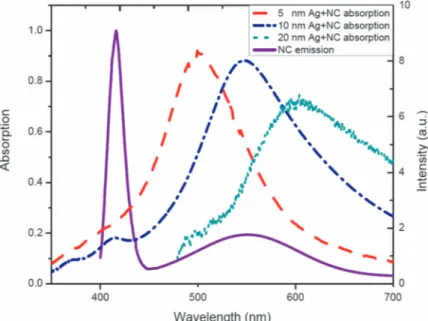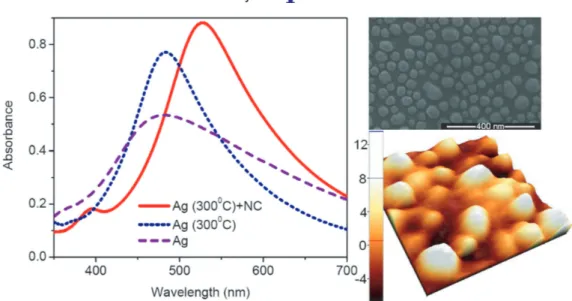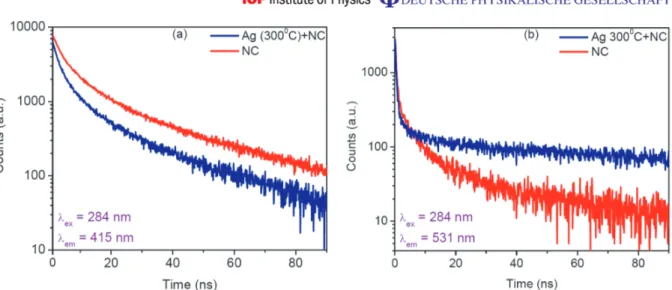Selective enhancement of surface-state emission
and simultaneous quenching of interband
transition in white-luminophor CdS nanocrystals
using localized plasmon coupling
To cite this article: Tuncay Ozel et al 2008 New J. Phys. 10 083035
View the article online for updates and enhancements.
Related content
White light generation by resonant nonradiative energy transfer from epitaxial InGaN/GaN quantum wells to colloidal CdSe/ZnS core/shell quantum dots
Sedat Nizamoglu, Emre Sari, Jong-Hyeob Baek et al.
-White emitting CdS quantum dot nanoluminophores hybridized on near-ultraviolet LEDs for high-quality white light generation and tuning
Sedat Nizamoglu, Evren Mutlugun, Ozgun Akyuz et al.
-Plasmonic light-sensitive skins of nanocrystal monolayers
Shahab Akhavan, Kivanc Gungor, Evren Mutlugun et al.
-Recent citations
Strong Enhancement of PbS Quantum Dot NIR Emission Using Plasmonic
Semiconductor Nanocrystals in Nanoporous Silicate Matrix
Aleksandr P. Litvin et al
-Instant Synthesis of White Light-Emitting Cd Chalcogenide Nanoclusters Using Homogenization Method
Priyesh V. More et al
-Thiol-Ligand-Catalyzed Quenching and Etching in Mixtures of Colloidal Quantum Dots and Silver Nanoparticles
Jae-Seung Lee et al
T h e o p e n – a c c e s s j o u r n a l f o r p h y s i c s
New Journal of Physics
Selective enhancement of surface-state emission
and simultaneous quenching of interband transition
in white-luminophor CdS nanocrystals using
localized plasmon coupling
Tuncay Ozel1, Ibrahim Murat Soganci1, Sedat Nizamoglu1, Ilkem Ozge Huyal1, Evren Mutlugun1, Sameer Sapra2, Nikolai Gaponik2, Alexander Eychmüller2
and Hilmi Volkan Demir1
1Department of Physics, Department of Electrical and Electronics Engineering,
Nanotechnology Research Center and Institute of Materials Science and Nanotechnology, Bilkent University, Ankara 06800, Turkey
2Physical Chemistry/Electrochemistry Group, Technische Universität Dresden,
Bergstr. 66b, Dresden 01062, Germany
E-mail:volkan@bilkent.edu.tr
New Journal of Physics10 (2008) 083035 (8pp) Received 24 June 2008
Published 26 August 2008
Online athttp://www.njp.org/
doi:10.1088/1367-2630/10/8/083035
Abstract. We propose and demonstrate the controlled modification and selec-tive enhancement of surface-state emission in white-luminophor CdS nanocrys-tals (NCs) by plasmon-coupling them with proximal metal nanostructures. By carefully designing nano-Ag films to match their localized plasmon resonance spectrally with the surface-state emission peak of CdS NCs, we experimen-tally show that the surface-state emission is substantially enhanced in the visible wavelength, while the interband (band-edge) transition at the shorter wavelength far away from the plasmon resonance is simultaneously significantly suppressed. With such plasmon tuning and consequent strong plasmon coupling specifi-cally for the surface-state transitions, the surface-state emission is made stronger than the band-edge emission. This corresponds to an enhancement factor of 12.7-fold in the ratio of the surface-state peak emission to the band-edge peak emission of the plasmon-coupled film sample compared with that in solution. Such a plasmonic engineering of surface-state emission in trap-rich CdS white nanoluminophors holds great promise for future solid-state lighting.
2
White nanoluminophors have attracted great attention for their potential use in solid-state lighting, which offers a remarkable level of reduction (expectedly of 50%) in the
global electrical energy consumption for lighting [1]. Among the examples of such white
nanoluminophors, semiconductor quantum dot nanocrystals (NCs) made of CdSe have previously been synthesized with a magic size of 1.5 nm in diameter to generate white
light [2]. Also, Mn-doped CdS NCs have been shown to emit white light as a result of
their collective emission in blue from CdS and in yellow from Mn d–d levels [3]. However,
these white nanoluminophors typically suffered from inconveniently low quantum efficiency (<10%) [2]–[5]. Recently, trap-rich CdS NCs have also been synthesized to provide surface-state emission with relatively high quantum efficiency (17%) [6]. These white-luminophor CdS NCs with an average diameter of 2.4 nm exhibited a band-edge emission (interband transition) from the conduction band to the valance band at 405 nm, along with a broad surface-state emission (SSE) that covers the entire visible spectrum arising from the mid-gap trap states. Although these NCs were intended for bright white-light emission, their white surface-state emission was undesirably much weaker (about 9 times weaker) than their band-edge emission.
In this paper, to address this problem, we propose selective localized plasmon coupling of the surface-state emission from these CdS nanoluminophors to make their surface-state emission stronger than their band-edge emission, as the first demonstration of plasmon-coupled surface-state emission using proximal metal nanostructures. To this end, by carefully tuning the localized plasmon resonance of nano-Ag films to spectrally match the surface-state emission peak of trap-rich CdS NCs, we experimentally demonstrate that the surface-state emission is substantially enhanced in the visible, whereas the band-edge emission at the shorter wavelength far away from the plasmon resonance is simultaneously significantly suppressed. This careful plasmon tuning and consequent strong plasmon coupling specifically for the surface-state transitions enabled the surface-state emission to be 6.8 times stronger than the band-edge emission for the first time. This corresponds to an enhancement factor of 12.7-fold in the ratio of the surface-state peak emission to the band-edge peak emission of the plasmon-coupled film sample compared with that in solution. These proof-of-concept demonstrations indicate that such a plasmonic engineering of surface-state emission in CdS white nanoluminophors holds great promise for future solid-state lighting.
To date, white light generation using different types of NC emitters has been successfully
demonstrated by our groups and others, e.g. in [7, 8]. Also, using different plasmonic
structures including patterned metal nanostructures, flat metal films, metal nano-island films and colloidal metal nanoparticles, plasmons have been extensively studied and have been previously demonstrated to enhance the photoluminescence (PL) of NC emitters, e.g. in [9]–[15]. Similarly, in the previous research works by our groups and many others, plasmon modes have also been shown to allow for the luminescence enhancement only in the close vicinity of plasmonic structures by creating very strongly localized electric fields in their near field and/or increasing radiative recombination rates of the coupled emitters, provided that a set of spectral and spatial conditions are satisfied, e.g. [9,13,16,17]. However, all of these previous studies focused only on enhancing the band-edge emission from these luminescent materials that takes place between their ground electronic e–h states from the conduction band to the valance band (interband transition). Selective enhancement of the surface-state emission through the mid-gap traps with plasmon coupling, on the other hand, has not been reported at all to date. Hence, this work proposes and demonstrates selective plasmon-coupled surface-state emission as the first proof-of-concept demonstration.
Figure 1. Experimental spectra of optical absorption, optical excitation (at the emission peak 415 nm), and PL (excited at the first exciton peak at 396 nm) of our surface-state emitting CdS NCs in solution. The insets illustrate emission from the conduction band (CB) to the valance band (VB) for the band-edge (interband) transition and through the mid-gap trap states for the surface-state emission (middle), along with a picture of near-white light emission from these SSE NC luminophors in solution under UV excitation (right).
In this work, we synthesized surface-state-emitting CdS NCs using the previously reported method [6]. For the synthesis, we dissolved 0.05 mmol of sulfur in 0.5 ml of octadecene (ODE) at 100◦C. At the same time, we separately dissolved 0.1 mmol of CdO in 0.83 mmol of oleic acid
(OA) and 4 ml of ODE in an argon atmosphere and heated them to 300◦C. We rapidly injected
the sulfur/ODE solution into the Cd/OA/ODE solution and cooled the mixture down to 280◦C,
waiting for 30 s. Then we cooled the solution further down to room temperature. NCs were precipitated using acetone, then washed several times with methanol and acetone for removing excess OA, and finally dissolved in toluene. Figure 1 presents the optical absorption, optical excitation and PL spectra of these trap-rich NCs in solution. Both in their optical absorption and excitation spectra, we observe that the first exciton peak is centered at 395 nm at room temperature. We measure the PL spectrum of our NC emitters at this best pump wavelength. In their PL spectrum, the full width at half maximum (FWHM) of the band-edge emission (the first peak) is observed to be 15 nm, and that of the surface-state emission (the second peak) is about 110 nm. Such a narrow band-edge emission is strong evidence of the monodispersity of our NCs. The broadband emission covering the entire visible spectrum comes from the trap states intentionally obtained within these small-sized NCs. In solution, the surface-state emission is found to be 8.9 times weaker than the band-edge emission.
To obtain a localized plasmon resonance in the visible region, we deposit Ag nano-island
films by the slow evaporation method (0.1–0.2 Å s−1) with film thicknesses below 25 nm on
4
Figure 2. Optical absorption spectra of a 5 nm thick silver nano-island film (dashed line), a 10 nm thick silver nano-island film (dashed–dotted line), and a 20 nm thick silver nano-island film (dotted line) with NC coating, for the demonstration of size-dependent plasmon resonance wavelength and spectral match with CdS SSE NCs in a PMMA polymer matrix (solid line).
are not continuous; instead they consist of nanometre-sized islands separated from each other. We study the size dependency of Ag islands both in vertical and lateral dimensions to obtain the optimal evaporation conditions for Ag and tune their size to obtain maximum spectral overlap with the surface-state emission of the NCs and achieve the best plasmon coupling possible. For
example, figure 2 shows the plasmon resonance wavelength of silver nano-island films tuned
by varying the silver film thickness from 5 to 10 to 20 nm (in the vertical dimension). We observe that the resulting plasmon resonance wavelength significantly depends on the thickness of the silver film, and that the peak absorption undesirably decreases and the FWHM of the peak increases with increasing film thickness. We therefore set the thickness of the silver nano-island film to 10 nm so as to match the surface-state emission wavelength range of the NC emitters and to possibly provide the best spectral match. For the lateral dimension optimization, figure 3shows the optical absorption spectra of 10 nm thick silver nano-island films tuned by varying their annealing conditions in the rapid thermal annealer. This post-annealing process effectively varies the lateral dimension of the silver islands. Here, we observe that with an
optimized annealing temperature of 300◦C for 10 min under N
2purge, nano-islands grow larger in lateral size but become more separated from each other, leading to a narrower and stronger optical absorption spectrum. Also, after integrating the annealed silver nano-island film with CdS SSE NCs dispersed in a poly(methyl methacrylate) (PMMA) matrix, a redshift of 45 nm is observed in the optical absorption spectrum with respect to its initial spectrum without NCs because the effective refractive index is increased with the addition of the NC-PMMA film. In our fabrication steps, we also take this redshift into account to optimize our plasmon coupling accordingly. The atomic force microscopy (AFM) and scanning electron microscopy (SEM) images show examples of these fabricated silver nano-island films with an average height of
Figure 3. Optical absorption spectra of a 10 nm thick silver nano-island film alone (dashed line), after 10 min annealing at 300◦C (dotted line) and with a 60 nm thick coating of CdS SSE NCs in a PMMA polymer matrix (solid line). The insets depict the SEM image (top) and AFM image (bottom) of our 10 nm thick silver nano-island film with a lateral size distribution of 25–75 nm.
10 nm in the vertical dimension and varying island sizes of 25–75 nm in the lateral dimension in the insets of figure3.
We prepare each sample to contain a 60 nm thick film of trap-rich CdS NCs in a PMMA
matrix (with an initial concentration of 5µM and an initial volume of 20 µl) on an Ag
nano-island film deposited on a quartz substrate. The negative control group includes an identical NC film placed directly on top of a quartz substrate (without Ag nano-islands). Here, we compare the PL spectra of these CdS NCs coupled with the silver island film against that of the negative control group (without silver plasmon coupling), both of which are excited at an
optical wavelength of 325 nm using an He–Cd laser. Figure 4 depicts these PL spectra taken
under completely identical experimental conditions. The resulting changes in the measured emission properties of CdS NCs when plasmon is coupled with the silver film are also displayed in table1, compared with the case of no plasmon coupling. These experimental results show that the silver nano-island film significantly suppresses the band-edge emission; at the same time, it selectively substantially enhances the state emission. As a result, the ratio of the surface-state emission peak to the band-edge emission peak increases by a factor of 6.8 in the film. This yields an enhancement factor of 12.7 for the plasmon-coupled film sample compared with that in solution. Additionally, because of these many trap states coupled with the plasmons, the total number of photons emitted at all wavelengths is also enhanced by 80%, meaning that the overall emission (including both the band-edge emission and the surface-state emission) is improved.
Figure 5 shows the time-resolved fluorescence decays of these CdS SSE NCs with and
without plasmon coupling: at the band-edge emission peak wavelength (415 nm) (figure 5(a))
and at the surface-state emission peak wavelength (531 nm) (figure5(b)). In the presence of the silver nano-island film, we observe that the band-edge emission is quenched and thus decays faster, while the trap-associated recombination becomes slower in the tail, compared with the NC film on bare quartz (with no plasmon coupling). These observed changes in the PL kinetics
6
Table 1. Systematic comparison of the band-edge and surface-state peak emission wavelengths, the band-edge and surface-state emission peak intensity levels, ratio of the surface-state emission to the band-edge emission, and the total number of photon counts in the emission spectrum, all these both for the control group (only surface-state emitting CdS NCs) and for the sample of surface-state emitting CdS NCs plasmon-coupled with a 10 nm thick silver nano-island film.
Surface-Material on Band-edge state λ1peak λ2peak Intensity Total
quartz emissionλ1 emissionλ2 intensity intensity ratio at number of
substrate (nm) (nm) (counts) (counts) λ2/at λ1 photons
Only SSE NC 415 545 1388 290 0.21 67 885
SSE NC with 415 531 672 960 1.43 122 055
10 nm Ag
Figure 4. PL spectra of a surface-state emitting CdS NCs film alone (dotted line) and when plasmon-coupled with a 10 nm thick silver nano-island film (solid line). The inset shows the picture of these NC luminophors on the silver nano-island film pumped with a 325 nm He–Cd laser.
along with those in the steady-state PL behavior are attributed to the enhanced efficiency of trap state population in the presence of the silver islands, and the nonradiative hole transition from the valence band of the CdS NCs to the trap states (k3in figure1, inset) is accelerated. Therefore the relatively long-lived PL associated with the surface traps (k2) becomes more pronounced,
whereas the band-gap-associated PL (k1) is partly quenched. The detailed mechanisms behind
these observed silver plasmon-mediated electron transitions are currently under investigation by our groups.
In conclusion, we have proposed and demonstrated selective plasmonic coupling of the surface-state emission in trap-rich CdS NC luminophors with metal island films by
Figure 5.Time-resolved PL traces of surface-state emitting CdS NCs alone (red) and when plasmon-coupled with a 10 nm thick Ag nano-island film (blue): (a) at the band-edge emission peak wavelength of 415 nm and (b) at the surface-state emission peak wavelength of 531 nm.
tuning their localized plasmon resonance wavelength to the surface-state emission peak. Our proof-of-concept experiments showed that the ratio of the surface-state emission in the visible to the band-edge emission is increased by more than 12 times, and the total number of emitted photons is increased overall by 80%, with a proper design and implementation of the proximal metal nanostructure and CdS NC luminophor films. Consequently, for the first time, the surface-state emission is made stronger than the band-edge emission by selective plasmon coupling of mid-gap traps. These results are highly promising for future NC-based solid-state lighting. Acknowledgments
This work was supported by EU PhOREMOST Network of Excellence (NoE) number 511616, EU Marie Curie International Reintegration Grant (MC-IRG MOON 021391) and Scientific and Technical Research Council of Turkey (TUBITAK) numbers 107E088, 107E297, 106E020, 104E114, 105E065 and 105E066. Also, HVD acknowledges additional support from the European Science Foundation (ESF) European Young Investigator Award (EURYI) and Turkish National Academy of Sciences (TUBA) Distinguished Young Scientist Award (GEBIP) programs. We thank Dr B Akata Kurc and S Canli for their assistance with high-resolution SEM imaging and we also gratefully acknowledge Professor Dr T Wolff (TU Dresden) for allowing us to use his time-resolved measurement equipment.
References
[1] OIDA 2001 The Promise of Solid-State Lighting for General Illumination (Washington, DC: Optoelectronics Industry Development Association)
[2] Bowers M J, McBride J R and Rosenthal S J 2005 J. Am. Chem. Soc.127 15378 [3] Nag A and Sarma D D 2007 J. Phys. Chem. C111 13641
8
[4] Norris D J, Sacra A, Murray C B and Bawendi M G 1994 Phys. Rev. Lett.72 2612 [5] Hoheisel W, Colvin V L, Johnson C S and Alivisatos A P 1994 J. Chem. Phys.101 8455 [6] Sapra S, Mayilo S, Klar T A, Rogach A L and Feldmann J 2007 Adv. Mater.19 569
Nizamoglu S, Mutlugun E, Akyuz O, Kosku Perkgoz N, Demir H V, Liebscher L, Sapra S, Gaponik N and Eychmüller A 2008 New J. Phys.10 023026
[7] Nizamoglu S, Ozel T, Sari E and Demir H V 2007 Nanotechnology18 065709 Nizamoglu S and Demir H V 2007 Nanotechnology18 405702
Demir H V, Nizamoglu S, Ozel T, Mutlugun E, Huyal I O, Sari E, Holder E and Tian N 2007 New J. Phys. 9 362
[8] Yeh D M, Huang C F, Lu Y C and Yang C C 2008 Appl. Phys. Lett.92 091112
Nizamoglu S, Mutlugun E, Özel T, Demir H V, Sapra S, Gaponik N and Eychmüller A 2008 Appl. Phys. Lett. 92 113110
Nizamoglu S, Zengin G and Demir H V 2008 Appl. Phys. Lett.92 031102
[9] Kulakovich O, Strekal N, Yaroshevich A, Maskevich S, Gaponenko S, Nabiev I, Woggon U and Artemyev M 2002 Nano Lett.2 1449
[10] Pompa P P, Martiradonna L, Torre A D, Sala F D, Manna L, Vittorio M D, Calabi F, Cingolani R and Rinaldi R 2006 Nat. Nanotechnol.1 126
Ito Y, Matsuda K and Kanemitsu Y 2007 Phys. Rev B75 033309
[11] Song J H, Atay T, Shi S, Urabe H and Nurmikko A V 2005 Nano Lett.5 1557
Hsieh Y P, Liang C T, Chen Y F, Lai C W and Chou P T 2007 Nanotechnology18 415707 [12] Ray K, Badugu R and Lakowicz J R 2006 J. Am. Chem. Soc.128 8998
[13] Soganci I M, Nizamoglu S, Mutlugun E, Akin O and Demir H V 2007 Opt. Express15 14289 [14] Okamoto K, Vyawahare S and Scherer A 2006 J. Opt. Soc. Am. B23 1674
[15] Komarala V K, Rakovich Y P, Bradley A L, Byrne S J, Gun’ko Y K, Gaponik N and Eychmüller A 2006
Appl. Phys. Lett.89 253118
[16] Fedutik Y, Temnov V, Schöps O, Woggon U and Artemyev M V 2007 J. Am. Chem. Soc.129 14939 Fedutik Y, Temnov V, Schöps O, Woggon U and Artemyev M V 2007 Phys. Rev. Lett.99 136802 [17] Futamata M, Maruyama Y and Ishikawa M 2003 J. Phys. Chem. B107 7607
Nakamura T and Hayashi S 2005 Japan. J. Appl. Phys.44 6833




